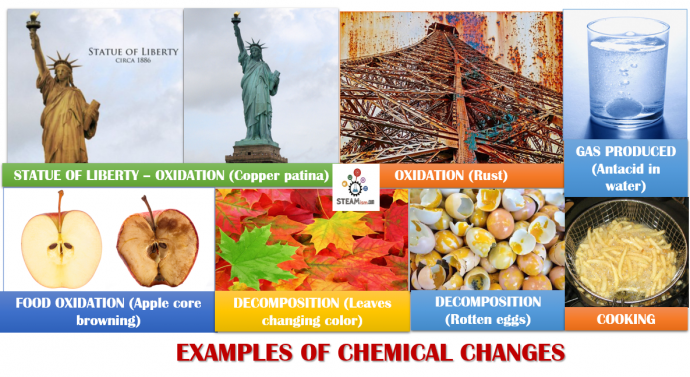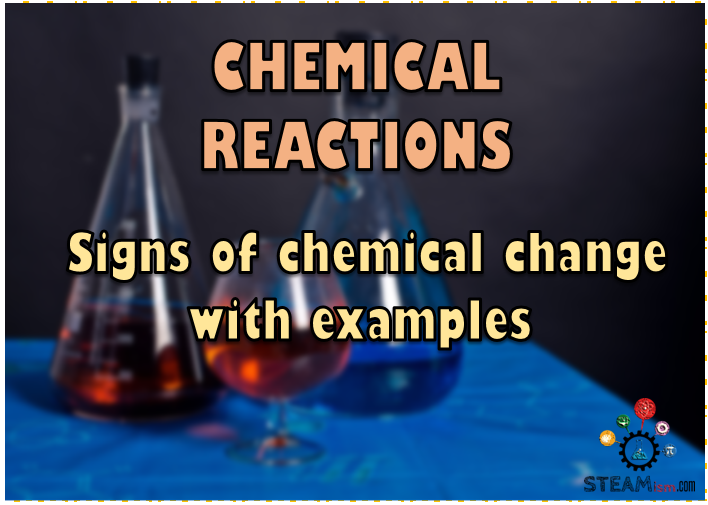A chemical reaction, also called a chemical change, is a process that leads to the chemical transformation of one set of chemical substances to another.
In a chemical reaction, the atoms in the substances rearrange themselves and then join back together in a different way. This creates new substances. Since we can’t see inside these atoms, we have to look for changes in the substance to spot a chemical change or reaction.
Chemical changes vs. Physical changes?
Remember physical changes? Think about ice for a moment. After ice melts into liquid water, you can refreeze it into solid ice if the temperature drops. Freezing and melting are physical changes. In a physical change, the composition of a substance does not change. In a chemical change, the composition of a substance does change.
Where do chemical reactions happen?
If you think chemical reactions only happen in test tubes in a lab, prepare to be surprised! Chemical reactions occur constantly in our environment with plants, animals, our own bodies, in the air around us that we breathe in and out, in the soil in which we grow our food and on which we build our homes and offices, in the hills and mountains that are untouched by humans, and in the lakes and oceans that gives us water and food.
In fact, there are so many chemical reactions that occur constantly, it may just be impossible understand them all.
5 Signs of Chemical Changes:
A chemical reaction can have occurred when one or more of the following things happen:
1. Color Change
2. Production of an odor
3. Change of Temperature
4. Evolution of a gas (formation of bubbles) – not to be confused with boiling
5. Precipitate (formation of a solid) – usually a sludgy or cloudy deposit, or crystals forming.
Sometimes, there are other signs – not visual like the above but felt or heard:
6. Heat produced
7. Sound produced, e.g. when an explosion takes place.
Examples of Chemical Reactions or Changes:
Like we said before, chemical reactions happen all around us, constantly! Let’s look at some fun examples, huh?
- Oxidation (patina) – Have you been to or seen a picture of America’s famous symbol – the Statue of Liberty 🗽? If yes, you know it’s a light-ish green in color, right? But did you know that the Statue is actually covered entirely in a layer of copper. We know by looking at a shiny penny that copper is a shiny pinkish-orange in color. So, this layer of copper on the Statue has gone through a series of chemical reactions. As the copper reacts with sulfur in the air, it forms copper sulfide. This then reacts with carbon dioxide in the air and hydroxide in water, to form a layer of patina that gives the statue its light green color. Guess what, chemical change!
- Oxidation (rust) – of iron, slowly, over a few months or years. Well, let’s talk about the Eiffel Tower which is made of iron. Yes, it doesn’t look rusty but that’s because there are other chemical changes involved. You have engineers and workmen who coat it with anti-rust coating every 7 years to prevent the original chemical reaction that may have happened – rust. So, there are more than 1 chemical reactions in play here.
- Oxidation (food) – Have you even half-eaten an apple 🍎 and thrown away the core? Do it today! If you come back to look at the core in a few hours, its color will have changed to an unappetizing brown. Chemical change!
- Leaves changing color – Is fall (autumn) your favorite season too? Perfect weather, and…leaves changing color🍂. That’s another chemical change!
- Food (eggs and others) decomposing – Ever smelled a rotten egg 🥚? It’s not easy for your nose 👃 to forget, right ? That’s a chemical change for odor change. Food spoils when left outside for too long. It’s a good way to see if it’s safe to eat, and is also a sign of a chemical change.
- Battery heating up – Have you even touched a battery 🔋 after it’s been on for a while? It’s heated up 🌡️, right? This is a sign that the battery converted some of its stored chemical energy into heat energy.
- Antacid in water – Drop an antacid 💊 into water. What do you see? Gas bubbles. Boom, chemical change.
- Photosynthesis – plants take in Carbon dioxide, perform their magic, and then release oxygen. That’s a chemical change.
- Respiration -🧘🏻 breathe in, breathe out 🧘🏻! Glucose in our bodies is converted to carbon dioxide and water, along with release of energy at the cells. Congratulations on your very own chemical reaction!
- Cooking – frying some french fries 🍟, maybe? Or baking a cake 🎂? All cooking changes the composition of the original food into something different, so – yes, you got it, chemical change.
- Combustion while driving – a vehicle 🚗. Cars and other automobiles burn gasoline or petrol in the process of combustion, which sets off multiple chemical reactions that make the vehicle move.
- Fireworks 🎆💥🎇 – The chemical burning reactions in fireworks vaporize the gunpowder and the color producing chemicals in it. The hot gas atoms frequently collide with each other in the firework explosion to produce heat and color.

Chemical reactions changes examples infographic
- An Interview with the Co-Founders of Dermanostix - August 14, 2020
- NASA & SpaceX’s Successful Space Launch - June 12, 2020
- Types of Engineering - June 10, 2020
